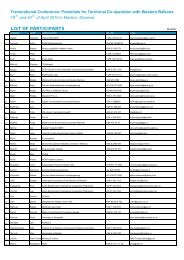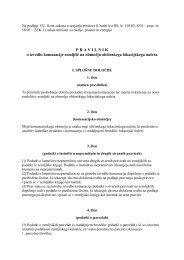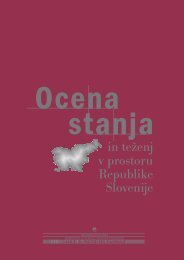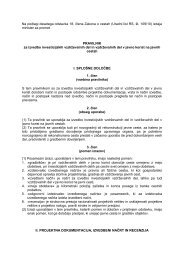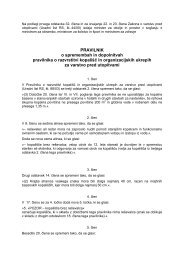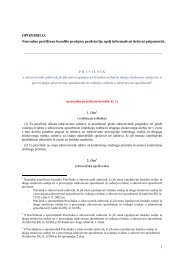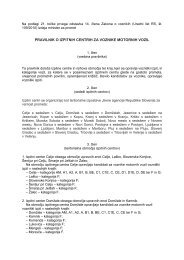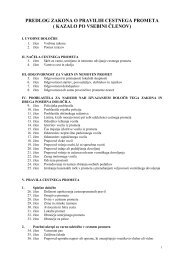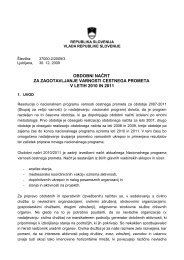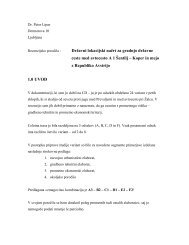omunski skupnosti), 3 stare liturgične cerkve(pripadale so lipovanski skupnosti), 1 katoliškacerkev, 1 protestantska cerkev, 1 anglikanskacerkev, 2 mošeji <strong>in</strong> armenska cerkev. Na popisuprebivalstva leta 1904 je število grškihprebivalcev doseglo 2.056 od skupnega številaprebivalcev, ki je znašalo 10.000. Mnogi soprišli z otoka Kefalonije, ki je del Jonskih otokov.Grška skupnost je bila največja v primerjavi zdrugimi kulturami: 803 Romuni, 444 Armenci,594 Lipovani, 286 Turki, 211 osebami iz Avstroogrskegacesarstva, 17 Nemci, itd. Del stalnihpredstavnikov Komisije je živel v mestu. Meščanigrškega izvora so se tradicionalno ukvarjali strgovanjem <strong>in</strong> plovbo, pri čemer so <strong>za</strong>vzemalivišje položaje na ladjah v Sul<strong>in</strong>skem rokavu,več<strong>in</strong>oma so bili lastniki ladij. Zgodov<strong>in</strong>ohelenske skupnosti danes izpričujejo spomeniki,ki prikazujejo njen razvoj, kot je grška cerkev na2. ulici, bivša šola na dvorišču cerkve ter večgrobnic iz ortodoksnega pokopališča, nekaterepričajo o zgodov<strong>in</strong>i določenih druž<strong>in</strong>, kot sodruž<strong>in</strong>a Ioanit, Svorono, Liosato, Kontoguro, itd.Kraj se je neprestano razvijal, razcvet pa jedoživel v 20. stoletju. Videz <strong>in</strong> razvoj mestaSul<strong>in</strong>a je tesno pove<strong>za</strong>n z ustanovitvijo Evropskekomisije <strong>za</strong> Donavo. Rečemo lahko celo, da jemesto Sul<strong>in</strong>a ustvarila Komisija.2.2. O gospodarstvuV Sul<strong>in</strong>i sonce vzhaja prej kot v preostali deželi,vendar je njegova naglica <strong>za</strong>man, saj razkrije lerevšč<strong>in</strong>o mesta, ki živi od lepih spom<strong>in</strong>ov.Obtičali med vodami so prebivalci ujetnikilastnega mesta. Iz Sul<strong>in</strong>e pelje potniška ladjaenkrat na dan <strong>za</strong> tiste, ki želijo v Tulceo. Pozimipride ladja enkrat na dva dni <strong>in</strong> če vodoprekrivajo nevarne ledene plošče, ladja sploh nepripelje. Ker ne morejo nikamor potovati,prebivalci Sul<strong>in</strong>e prav tako nimajo avtomobilov.V mestu, kjer živi skoraj 5000 ljudi, je samo 65avtomobilov. Javnega prevo<strong>za</strong> ni, ker so razdaljetako majhne kot pri kakšni vasi. Seveda ni nititaksijev, ker jih nihče ne bi uporabljal. Spomladi<strong>in</strong> jeseni, ko je megla gostejša kot običajno, vmesto ne more prispeti niti helikopter bolnišniceiz Tulcee ali od drugod. Če ima katerikoli meščansmolo, da zboli, se mora sprijazniti zzdravljenjem dveh mestnih zdravnikov vbolnišnici, ki je tudi sama v zelo slabem stanju.Statistično gledano je 40 % prebivalcev Sul<strong>in</strong>ebrezposelnih, vendar obstajajo tudi drugi, ki nisovpisani v uradne evidence. V Sul<strong>in</strong>i se je časustavil. Zgradbe, ki so nekoč bile elegantne,Church on the 2 nd street, the previous schoolbuild<strong>in</strong>g <strong>in</strong> the church’s courtyard, as well as thepresence of several tombs from the orthodoxgraveyard, some of them show<strong>in</strong>g the evolution<strong>in</strong> time of certa<strong>in</strong> families, such as the Ioanits,the Svoronos, the Liosatos, the Kontoguros, etc.The locality went through cont<strong>in</strong>uous evolution,reach<strong>in</strong>g its most prosperous time <strong>in</strong> the 20 thcentury. The appearance and development ofSul<strong>in</strong>a city is highly bound by the constitution ofthe European Commission of the Danube. Wemight as well consider Sul<strong>in</strong>a’s emplacement asone of Commission’s creation.2.2. About economyIn Sul<strong>in</strong>a, the sun arrives earlier then <strong>in</strong> the restof the country, but its haste is <strong>in</strong> va<strong>in</strong>, becauseit does noth<strong>in</strong>g else but reveals the poverty of acity that lives through beautiful memories. Stuckamong waters, the <strong>in</strong>habitants are prisoners <strong>in</strong>their own city. From Sul<strong>in</strong>a, a passenger shiptakes one voyage a day for those who want toreach Tulcea. In the w<strong>in</strong>ter, the ship comes once<strong>in</strong> two days, and if there are any dangerous icicles,it doesn’t come at all. Because they havenowhere to go, the <strong>in</strong>habitants of Sul<strong>in</strong>a have nocars, either. There are only 65 cars <strong>in</strong> a city ofalmost 5000 souls. There is no local transportation,because the distances are as small asthose of a village. Least of all, cabs, because theywould be completely useless. In spr<strong>in</strong>g and autumn,when the fog is thicker than usual, noteven the helicopter of a hospital from Tulcea oranywhere else can make it. If any local has themisfortune of gett<strong>in</strong>g sick, they must do withbe<strong>in</strong>g healed by two <strong>in</strong>mate doctors, <strong>in</strong> a hospitalthat is <strong>in</strong> a coma itself. Statistically, 40% ofSul<strong>in</strong>a’s <strong>in</strong>habitants are unemployed, but thereare also others who have escaped the authorities’evidence. The time of Sul<strong>in</strong>a has died. Build<strong>in</strong>gsthat were once elegant, an abandonedchurch, roads as dusty as the rural ones, abandonedfactories. Stone still somewhere betweenthe ages, we only hear of Sul<strong>in</strong>a if it’s be<strong>in</strong>gflooded or it appears on the list of the cities <strong>in</strong>quarant<strong>in</strong>e.Sul<strong>in</strong>a feeds on its memories. Until 1989, fourquick ship voyages and one passenger shipbrought 1500 tourists daily. They were hosted <strong>in</strong>the <strong>in</strong>habitants’ houses or <strong>in</strong> the 150 room hotel,which is now completely neglected. The localsused to work at the can factory or the shipyard.Both became private property and diedslowly.179Delavnica 2 / Workshop 2
180Delavnica 2 / Workshop 2<strong>za</strong>puščene cerkve, ceste, ki so tako prašne kotna podeželju, <strong>za</strong>puščene tovarne. Mrtvaškatiš<strong>in</strong>a jo je prekrila nekje na sredi poti <strong>in</strong> o Sul<strong>in</strong>islišimo le takrat, ko jo <strong>za</strong>livajo poplave ali ko sepojavi na spisku mest v karanteni.Sul<strong>in</strong>a se hrani s svojimi spom<strong>in</strong>i. Do leta 1989so štiri hitre ladje <strong>in</strong> ena potniška pripeljale 1500turistov na dan. Gostili so jih v hišah prebivalcevali v hotelu s 150 sobami, ki je sedaj popolnoma<strong>za</strong>nemarjen. Domač<strong>in</strong>i so bili <strong>za</strong>posleni v mestnitovarni konzerv ali v ladjedelnici. Obe sta seprivatizirali <strong>in</strong> sčasoma propadli.Še več, Sul<strong>in</strong>a živi od spom<strong>in</strong>a, kakšne so bilerazmere na <strong>za</strong>četku 20. stoletja. Od 1856 do1939 je to mesto bilo sedež ECD, ustanovljenemz mirovniško pogodbo po Krimski vojni,ko je bila uveljavljena prosta plovba po Donavi.Postala je svetovljansko mesto, njen uradni jezikje bil francošč<strong>in</strong>a <strong>in</strong> gršč<strong>in</strong>a najbolj razširjenijezik. Zraven tega so bili domač<strong>in</strong>i poligloti, sajje skupaj živelo 28 narodnosti. Pristanišče vSul<strong>in</strong>i je bilo deležno davčnih olajšav <strong>in</strong> če so vdrugih evropskih pristaniščih delavci <strong>za</strong>služilifunt na dan, so jih tukaj štiri.Ladjedelnica se skuša rešiti. Zgrajena je bila leta1895, takrat kot je bila ustanovljena Evropskakomisija, <strong>in</strong> je kasneje postala del Plovne upravev spodnjem toku Donave. Od leta 1982 jeLadjedelnica Sul<strong>in</strong>e neodvisna družba. Imela je280 <strong>za</strong>poslenih <strong>in</strong> je ustvarjala približno 50milijonov lei na leto v času, ko je kruh stal 3 lei.Po revoluciji se je število naročil zmanjšalo <strong>in</strong>število romunskih ladij, tako kot <strong>za</strong>poslenih, jeupadlo. Po letu 1989 so ljudje v Sul<strong>in</strong>i postalibrezposelni. Tovarna konzerv se je <strong>za</strong>prla <strong>in</strong>brezposelnih je postalo 40 % prebivalcev. Danessamo 188 ljudi prejema nadomestilo, medtemko je v Sul<strong>in</strong>i 3139 ljudi, sposobnih <strong>za</strong> delo.Vendar ko je ladjedelnica <strong>za</strong>čela najemati ljudi,se le-ti niso <strong>za</strong>nimali <strong>za</strong> razpoložljiva delovnamesta. Leta 2002 se je podjetje privatiziralo.Takrat je ladjedelnica imela mnogo dolgov <strong>in</strong> jebila tik pred stečajem (imela je le 60 <strong>za</strong>poslenih).Po privati<strong>za</strong>ciji se je število <strong>za</strong>poslenih povečalo,prav tako pa proizvodnja. Leta 2003 jeladjedelnica proizvedla 16 milijard lejev <strong>in</strong> število<strong>za</strong>poslenih je doseglo 94, od katerih je 78neposredno produktivnih. Ladjedelnica Sul<strong>in</strong>epopravlja vse vrste tehnoloških ladij, ki plujejo poDonavi.But more than that, Sul<strong>in</strong>a lives with thememory of what it used to be at the beg<strong>in</strong>n<strong>in</strong>gof the 20 th century. From 1856 to 1939, this citywas the residence of the ECD, founded throughthe peace treaty after the Crimean War, whenthe freedom of navigation on the Danube wasestablished. It became a cosmopolitan city,which had French as its official language andGreek as its mostly spoken language. Besides,the <strong>in</strong>habitants were polyglots, because 28 nationalitieslived together. The Sul<strong>in</strong>a harbor receivedfiscal privileges and, if <strong>in</strong> other Europeanharbors, the workers received one pound a day,here they earned four.The rema<strong>in</strong>ders of the English, the French, theGreeks, the Italians, the Hungarians, the Serbo-Croatians, the Muslims, the Jewish and of otheroutstand<strong>in</strong>g people that connected their nameswith that of Sul<strong>in</strong>a, can only be found <strong>in</strong> the citygraveyard, with impressive monuments, but devastated.It’s the only graveyard of Romaniawhere rest together believers of the three greatreligions. In the last 50 years, the ignorance ofthe people has destroyed most of the maritimegraveyard of Sul<strong>in</strong>a, almost 150 years old. Tombfences have become enclosures for local gardens,tombstones have become pavement for alleys,and wrought iron crosses have been sold asmonuments <strong>in</strong> Tulcea or Constanta.The Shipyard tries to shift. It was built <strong>in</strong> 1895,along with the European Communion, and laterbecame part of the Down Danube Fluvial Adm<strong>in</strong>istration.S<strong>in</strong>ce 1982, the Shipyard of Sul<strong>in</strong>abecame an <strong>in</strong>dependent society. It had 280employees and produced approximately 50 millionlei a year, when bread cost 3 lei. After theRevolution, the number of charges decreased,and the number of Romanian ships, as well asemployees, dim<strong>in</strong>ished. In Sul<strong>in</strong>a, after 1989, thepeople were left unemployed. The can factorywas closed, and it is said 40% of the <strong>in</strong>habitantsare unemployed. Now, only 188 receive allowance,out of the 3139 people capable of work <strong>in</strong>Sul<strong>in</strong>a. Although, when the Shipyard started hir<strong>in</strong>g,the people were not <strong>in</strong>terested <strong>in</strong> the jobsavailable.In January 2002, the company becameprivate property. In that moment, the Shipyardhad many debts and was almost bankrupt(it only had 60 employees). After privati<strong>za</strong>tion,the number of employees <strong>in</strong>creased, and so didthe production. In 2003, the Shipyard produced16 billion lei and the number of employeesreached 94, from which 78 are directly produc-
- Page 6:
UvodIntroductionCilj Evropske konve
- Page 9 and 10:
VsebinaContentUVOD / INTRODUCTION 5
- Page 11:
mag. Marko Prem 260Upravljanje kraj
- Page 14 and 15:
dejavnikov je torej vplivalo na to,
- Page 16 and 17:
METKA ČERNELČGeneralna direktoric
- Page 18:
avneh vključuje in usmerja razvoj
- Page 21 and 22:
Pozdravni nagovori/ Welcoming Speac
- Page 23 and 24:
Pozdravni nagovori/ Welcoming Speac
- Page 25 and 26:
Pozdravni nagovori/ Welcoming Speac
- Page 27 and 28:
Pozdravni nagovori/ Welcoming Speac
- Page 29 and 30:
Pozdravni nagovori/ Welcoming Speac
- Page 32 and 33:
DELAVNICA WORKSHOP 1Inventarizacija
- Page 34 and 35:
vsega tega je bil razpršen sistem
- Page 36 and 37:
žalost pa je bilo izdelanih le mal
- Page 38 and 39:
področje varstva in razvoja kultur
- Page 40 and 41:
- Odstranjujejo potrebo po optimira
- Page 42 and 43:
dejstvo pa je, da omogoča sodelova
- Page 44 and 45:
Krajina kot nacionalni simbolLandsc
- Page 46 and 47:
2. Diagram cikličnih interakcij me
- Page 48 and 49:
prostorom skladne predstave, h kate
- Page 50 and 51:
pojmovana kot država ali kot regij
- Page 52 and 53:
Pri razvijanju Evropske konvencije
- Page 54 and 55:
Regionalna razdelitev krajinskih ti
- Page 56 and 57:
1. 1. Postopek krajinske regionaliz
- Page 58 and 59:
jih intenzivnejšega prostorskega r
- Page 60 and 61:
Krajina je bila vrednotena na lestv
- Page 62 and 63:
Pojem prepoznavnosti krajine je v S
- Page 64 and 65:
e) in the development of agricultur
- Page 66 and 67:
krajine kot demokratičnega koncept
- Page 68 and 69:
ni mogoče »varovati«; takšen pr
- Page 70 and 71:
16. HLC on the web - Devon (made by
- Page 72 and 73:
kot je bilo omenjeno že zgoraj, po
- Page 74 and 75:
Razvijanje rešitev, ki zagotavljaj
- Page 76 and 77:
je mogoče ohraniti v rezervatu, ve
- Page 78 and 79:
kar je v velikem nasprotju z region
- Page 80 and 81:
vodi k zanimivim možnostim za disc
- Page 82 and 83:
namerava na novo ukrojiti kulturne
- Page 84 and 85:
Pogoj, ki ga ne moremo izključiti
- Page 86 and 87:
dejavnosti, da bi zagotovili večjo
- Page 88 and 89:
scape in consolidating their own id
- Page 90 and 91:
Delamo pod vplivom paradoksa: kraji
- Page 92 and 93:
skupine modelov za spreminjanje oko
- Page 94 and 95:
zamišljeni z namenom sobivanja, pa
- Page 96 and 97:
meri 13 kilometrov in priča o viso
- Page 98 and 99:
po našem mnenju moralo služiti ko
- Page 100 and 101:
Glede druge točke pa: umetniki so
- Page 102 and 103:
Vloge, ki jih odigrajo igralci in t
- Page 104 and 105:
Podoba prostora izhaja iz fizičneg
- Page 106 and 107:
Diskusija ob koncu delavnice je bil
- Page 108:
107Delavnica 1 / Workshop 1
- Page 111 and 112:
Pomen kakovostne krajine za boljšo
- Page 113 and 114:
112Delavnica 2 / Workshop 2krajinsk
- Page 115 and 116:
114Delavnica 2 / Workshop 2Evropski
- Page 117 and 118:
116Delavnica 2 / Workshop 2politiko
- Page 119 and 120:
UNESCOVA izbira kulturne krajine:pr
- Page 121 and 122:
120Delavnica 2 / Workshop 2proti re
- Page 123 and 124:
122Delavnica 2 / Workshop 2štiri s
- Page 125 and 126:
124Delavnica 2 / Workshop 2Nedavni
- Page 127 and 128:
126Delavnica 2 / Workshop 2Poudarja
- Page 129 and 130: Vključenost krajine v javne politi
- Page 131 and 132: 130Delavnica 2 / Workshop 2Dostopno
- Page 133 and 134: 132Delavnica 2 / Workshop 2»od zgo
- Page 135 and 136: 134Delavnica 2 / Workshop 2kmetijst
- Page 137 and 138: 136Delavnica 2 / Workshop 2Transpor
- Page 139 and 140: 138Delavnica 2 / Workshop 2Krajinsk
- Page 141 and 142: 140Delavnica 2 / Workshop 2kmetijst
- Page 143 and 144: Krajina kot vir za razvoj turizma (
- Page 145 and 146: 144Delavnica 2 / Workshop 2zanimajo
- Page 147 and 148: 146Delavnica 2 / Workshop 224. E. K
- Page 149 and 150: 148Delavnica 2 / Workshop 2Za podro
- Page 151 and 152: Vloga celovite presoje vplivov na o
- Page 153 and 154: 152Delavnica 2 / Workshop 2trajnost
- Page 155 and 156: 154Delavnica 2 / Workshop 2verjeten
- Page 157 and 158: 156Delavnica 2 / Workshop 2Krajina
- Page 159 and 160: 158Delavnica 2 / Workshop 2Izkušnj
- Page 161 and 162: 160Delavnica 2 / Workshop 2V primer
- Page 163 and 164: 162Delavnica 2 / Workshop 2podežel
- Page 165 and 166: open to opinions from a wider exper
- Page 167 and 168: 166Delavnica 2 / Workshop 2zasedanj
- Page 169 and 170: 168Delavnica 2 / Workshop 2INTERREG
- Page 171 and 172: 170Delavnica 2 / Workshop 2naravnih
- Page 173 and 174: 172Vse države (države članice, d
- Page 175 and 176: 174Delavnica 2 / Workshop 2stežka
- Page 177 and 178: 176Delavnica 2 / Workshop 2Delta Do
- Page 179: 178Delavnica 2 / Workshop 2podkonzu
- Page 183 and 184: 182Delavnica 2 / Workshop 2Suline:-
- Page 185 and 186: 184Delavnica 2 / Workshop 2Z razvoj
- Page 187 and 188: 186Delavnica 2 / Workshop 2sent, ki
- Page 189 and 190: 188Delavnica 2 / Workshop 2težko,
- Page 191 and 192: Od nočne krajine, ki jo razsvetlju
- Page 193 and 194: 192Delavnica 2 / Workshop 2Seznanja
- Page 195 and 196: 194Delavnica 2 / Workshop 2ukrepa p
- Page 197 and 198: 196Delavnica 2 / Workshop 2Nočno t
- Page 199 and 200: . . . . . . . . . . .. . . . . . .
- Page 201 and 202: Varstvo in upravljanje krajine v Sl
- Page 203 and 204: 202Delavnica 3 / Workshop 3varovani
- Page 205 and 206: 204Delavnica 3 / Workshop 3Sprememb
- Page 207 and 208: 206Delavnica 3 / Workshop 3način p
- Page 209 and 210: 208Delavnica 3 / Workshop 3Načrtov
- Page 211 and 212: 210Delavnica 3 / Workshop 3dela, ce
- Page 213 and 214: 212Delavnica 3 / Workshop 3številn
- Page 215 and 216: 214Delavnica 3 / Workshop 3Krajinsk
- Page 217 and 218: Varstvo in upravljanje krajine:izku
- Page 219 and 220: 218Delavnica 3 / Workshop 3številn
- Page 221 and 222: Kulturna krajina kot kulturna dedi
- Page 223 and 224: 222Delavnica 3 / Workshop 3naravnih
- Page 225 and 226: 224Delavnica 3 / Workshop 3(Gorjanc
- Page 227 and 228: 226Delavnica 3 / Workshop 31. njivs
- Page 229 and 230: 228Delavnica 3 / Workshop 3V. Smern
- Page 231 and 232:
230Delavnica 3 / Workshop 3- prikaz
- Page 233 and 234:
232Delavnica 3 / Workshop 3prepozna
- Page 235 and 236:
Krajina in suburbanizirana območja
- Page 237 and 238:
236Delavnica 3 / Workshop 3dejanske
- Page 239 and 240:
238Delavnica 3 / Workshop 3Morfolo
- Page 241 and 242:
240Delavnica 3 / Workshop 3vendar v
- Page 243 and 244:
242Delavnica 3 / Workshop 3turisti
- Page 245 and 246:
244Delavnica 3 / Workshop 3preobrem
- Page 247 and 248:
246Delavnica 3 / Workshop 3okolja r
- Page 249 and 250:
248Delavnica 3 / Workshop 3Politika
- Page 251 and 252:
250Delavnica 3 / Workshop 3uveljavi
- Page 253 and 254:
252Delavnica 3 / Workshop 3Obiskova
- Page 255 and 256:
2549. Ali so župani parkov razdvoj
- Page 257 and 258:
256Delavnica 3 / Workshop 3v izjemn
- Page 259 and 260:
258Delavnica 3 / Workshop 3Ta mrež
- Page 261 and 262:
Urejanje krajine v obalnih območji
- Page 263 and 264:
262Delavnica 3 / Workshop 3zelenih
- Page 265 and 266:
264Delavnica 3 / Workshop 3obalnih
- Page 267 and 268:
266Delavnica 3 / Workshop 3značiln
- Page 269 and 270:
268Delavnica 3 / Workshop 3Korčula
- Page 271 and 272:
270Delavnica 3 / Workshop 3njem raz
- Page 273 and 274:
272Delavnica 3 / Workshop 3da so se
- Page 275 and 276:
274Delavnica 3 / Workshop 3načrtov
- Page 277 and 278:
276Delavnica 3 / Workshop 3Vpliv pr
- Page 279 and 280:
278Delavnica 3 / Workshop 38. Zaklj
- Page 281 and 282:
. . . . .. . . . . . . .. . . . . .
- Page 283 and 284:
Veščine usposabljanja javnosti za
- Page 285 and 286:
284Delavnica 4 / Workshop 4pod kak
- Page 287 and 288:
286Delavnica 4 / Workshop 4Metoda 1
- Page 289 and 290:
288Delavnica 4 / Workshop 4širokeg
- Page 291 and 292:
290Delavnica 4 / Workshop 4- Združ
- Page 293 and 294:
292Delavnica 4 / Workshop 4mladino
- Page 295 and 296:
294Delavnica 4 / Workshop 4Povezave
- Page 297 and 298:
Strategija izobraževanja o prostor
- Page 299 and 300:
298Delavnica 4 / Workshop 4Za trajn
- Page 301 and 302:
300Delavnica 4 / Workshop 4in nikol
- Page 303 and 304:
302Delavnica 4 / Workshop 4- upošt
- Page 305 and 306:
304Delavnica 4 / Workshop 4večstra
- Page 307 and 308:
306Delavnica 4 / Workshop 4Poglavit
- Page 309 and 310:
308Delavnica 4 / Workshop 4- začet
- Page 311 and 312:
310Delavnica 4 / Workshop 4krajini,
- Page 313 and 314:
312Delavnica 3 / Workshop 3Vsi nagr
- Page 315 and 316:
Splošni zaključki / General concl
- Page 317 and 318:
Splošni zaključki / General concl
- Page 319 and 320:
Splošni zaključki / General concl
- Page 321 and 322:
Splošni zaključki / General concl
- Page 323 and 324:
Splošni zaključki / General concl
- Page 325 and 326:
Splošni zaključki / General concl
- Page 327 and 328:
Splošni zaključki / General concl
- Page 329 and 330:
Seznam avtorjevList of SpeakersFran
- Page 331 and 332:
Nicolas SANAAZdruženje regionalnih
- Page 333:
FRIDAY 12 MAY 2006PROGRAMMEWORKSHOP



